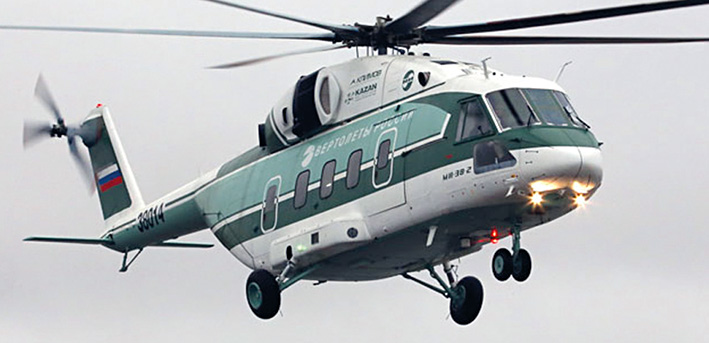|
 The first flight of the fourth flying prototype of the advanced Mil Mi-38 medium transport helicopter took place in Kazan, at the airfield of Kazan Helicopters, a subsidiary of the Russian Helicopters holding company, on 16 October 2014. The fourth prototype (OP-4) with side number 38014 was made in the Mi-38-2 variant powered by advanced Russian-developed Klimov TV7-117V turboshafts. Unlike the previous Mi-38 prototypes, OP-4 features enlarged windows and a advanced shock-protected fuel system. The machine is being considered as the standard for future production Mi-38s. OP-4's first hover was performed in Kazan by the crew of Honoured Test Pilot Vladimir Kutanin. The aircraft will undergo further tests at the flight test facility of the Mil Helicopter Plant in Tomilino, Moscow Region. The first flight of the fourth flying prototype of the advanced Mil Mi-38 medium transport helicopter took place in Kazan, at the airfield of Kazan Helicopters, a subsidiary of the Russian Helicopters holding company, on 16 October 2014. The fourth prototype (OP-4) with side number 38014 was made in the Mi-38-2 variant powered by advanced Russian-developed Klimov TV7-117V turboshafts. Unlike the previous Mi-38 prototypes, OP-4 features enlarged windows and a advanced shock-protected fuel system. The machine is being considered as the standard for future production Mi-38s. OP-4's first hover was performed in Kazan by the crew of Honoured Test Pilot Vladimir Kutanin. The aircraft will undergo further tests at the flight test facility of the Mil Helicopter Plant in Tomilino, Moscow Region.
Earlier last year, the trials of the first Mi-38 prototype (OP-1) converted to the Mi-38-2 version commenced in Tomilino. As is known, during the first phase of the flight test programme, which had been under way since 2003 in Kazan and then in the Moscow Region, the OP-1 prototype was powered by Pratt & Whitney Canada XPW127/5 experimental engines. The prototype's conversion to the domestic powerplant consisting two TV7-117V turboshafts and upgraded powertrain and their debugging on board the helicopter kicked off in 2011. At the same time, Kazan Helicopters manufactured the third Mi-38 prototype, the Mi-38-2 (OP-3), powered by a pair of TV7-117Vs too. Its flight tests in Tomilino commenced in November 2013, and the upgraded Mi-38-2 (OP-1) flew there in April 2014. Mention should be made that the second Mi-38 prototype, the XPW127/5-powered OP-2, is airworthy now too.
The TV7-117V-powered Mi-38-2 and PW127TS-powered Mi-38-1 have a maximum takeoff weight of 15,600 kg (16,200 kg with under-slung cargo) and haul 6 t of cargo in the cabin or 7 t slung under belly at a cruising speed of 285 km/h. The cabin can seat 30 passengers. The helicopter also is offered in the search-and-rescue, medevac, offshore and VIP versions, while surpassing other machines in the class in terms of the carrying and seating capacities.
Mi-38-2 in a cargo version is to be certificated by the IAC's Aviation Register in December 2015. Kazan Helicopters is assembling the airframe of the first production-standard Mi-38 now.
(Photo: Russian Helicopters)
|
